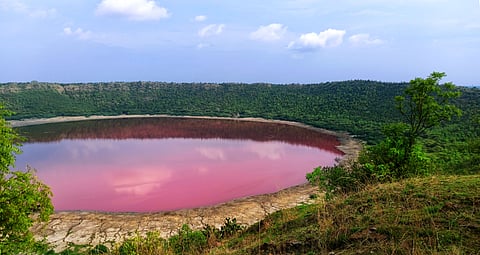
- Destinations
- Experiences
- Stay
- What's new
- Celebrating People
- Responsible Tourism
- CampaignsCampaigns
- Subscribe
- Buy Now

In the Buldhana district of Maharashtra, there is a remarkable lake that uniquely combines geology, ecology, and culture: Lonar Crater Lake. This lake was formed thousands of years ago by a meteorite impact. It is a rare natural wonder, characterised by its saline and alkaline waters, and is surrounded by lush forests and historic temples. Lonar Crater Lake attracts a diverse group of visitors, including scientists, pilgrims, and birdwatchers.
The only hyper-velocity impact crater on basaltic rock in the world is Lonar Crater Lake. A meteorite striking the basalt layers of the Deccan Traps created the perfectly round basin, which is 1.8 km wide and roughly 150 m deep. The strong collision is confirmed by geological evidence, including evidence like shocked breccia and shatter cones. While some dating techniques indicate the crater may be more than half a million years old, estimates place its formation at about 52,000 years ago.
With its water reaching a pH of nearly 11, the lake is both saline and alkaline. Such extreme conditions make it inhospitable for most aquatic beings to thrive. Yet, the lake supports unique microbial communities, including nitrogen-fixing organisms adapted to harsh conditions. Along its shores, evaporating water deposits soda and carbonate salts, which were once collected for local use.
The biodiversity of Lonar is exceptionally rich, despite its harsh chemical conditions. Black-winged stilts, Brahminy ducks, shelducks, teals, herons, baya weavers, parakeets, and robins are among the approximately 160 bird species that call it home. In the winter, migratory birds are particularly noticeable. The lake is a component of the Lonar Wildlife Sanctuary, which covers an area of 365 hectares. Mammals including langurs, deer, and wild boar, as well as reptiles like monitor lizards, can be found in the dry deciduous forests that surround them. Peacocks are also commonly seen here.
Lonar enjoys a deep cultural importance, with references going as far as the ancient texts such as the Skanda Purana and the Ain-i-Akbari. The crater rim and basin are dotted with historic temples, though many are now in ruins.
The most prominent of these ruins is the Daitya Sudan Temple, dedicated to Lord Vishnu’s victory over the demon Lonasura. Built in the Hemadpanthi style, it is a significant example of medieval architecture. Other temples around the lake include Vishnumandir, Wagh Mahadev, Mora Mahadev, Munglyacha Mandir, and the temple of Goddess Kamalaja Devi.
A permanent freshwater stream flows from a cow-shaped rock at the Gomukh Temple, standing on the rim of the crater. A Hanuman shrine with an idol carved from magnetic rock that is thought to exhibit natural magnetism is located within the basin. These temples enhance the site's scientific relevance with layers of devotion and myth.
Scientists with international renown have long been interested in Lonar. The site's geology, ecology, and microbiology have been investigated by researchers from the Smithsonian Institution, the Geological Survey of India, and other international institutions. To emphasise its significance as a wetland of global importance, Lonar Crater Lake was named a Ramsar site in 2020. Further, in an effort to secure UNESCO World Heritage designation, the Maharashtra government set aside a fund of ₹369 crores in 2022 for the lake's preservation and tourism growth.
Lonar is almost 140 kilometres from Aurangabad and is situated in the Buldhana district. The closest train stations are located within driving distance of the crater at Shegaon, Partur, and Jalna. It is reachable from Maharashtra's major cities by road connectivity. Near the lake, the Maharashtra Tourism Development Corporation (MTDC) runs a resort that provides guests with simple lodging.
Lonar Crater Lake remains an unparalleled natural site; an ancient meteorite impact preserved in basalt, with its saline-alkaline water that sustains unique microbiological life and thriving bird populations. It functions as a peculiar scientific laboratory and a cultural setting, with historic temples situated beside it. The site gives tourists the chance to witness one of the world's most distinctive natural wonders.
